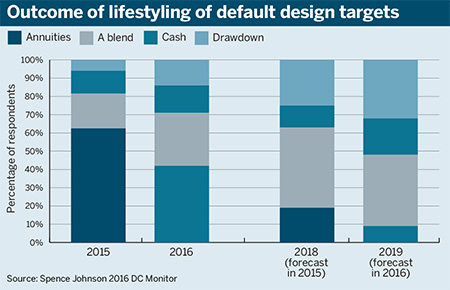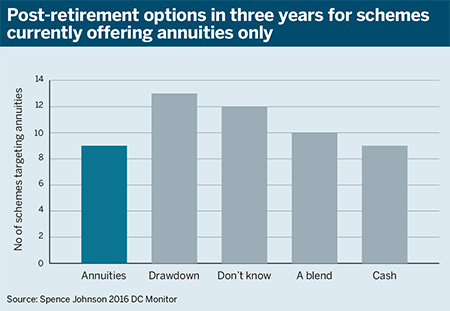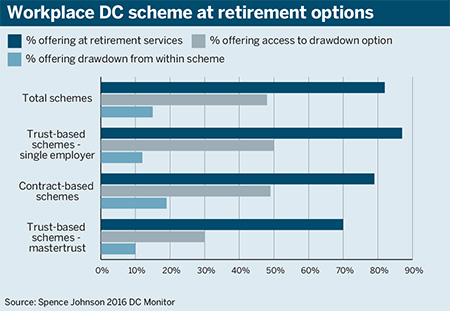What proportion of defined contribution schemes still target annuities, and is in-scheme drawdown likely to increase? Magnus Spence from SpenceJohnson analyses the DC landscape.
The shift away from annuities that has arisen as a result of the pension freedoms is clear in the response from our annual DC Monitor surveys in 2015 and 2016. Compared with the 62 per cent of schemes targeting annuities in 2015, 42 per cent of the respondents to our 2016 survey are doing so.
The percentage of respondents targeting a blend of annuities, cash or drawdown increased by 10 percentage points, 3 percentage points and 9 percentage points respectively.
Analysis of the future plans of schemes indicates that the decline in the number of schemes targeting annuities will decrease further. Their forecasts suggest just 9 per cent of schemes will be targeting annuities in 2019, which is an additional reduction from last year’s forecast for 2018, which suggested that 19 per cent of schemes would still have annuities as the target for their default funds.
By 2019, 32 per cent of schemes are expecting to be targeting drawdown, 20 per cent of schemes are expecting to be targeting cash, and 39 per cent of schemes are expecting to be targeting a blend of outcomes.

Looking just at the schemes that are currently targeting annuities, 25 per cent are expecting to be targeting drawdown in three years’ time, 17 per cent of schemes are expecting to be targeting cash, and 19 per cent of schemes are expecting to be targeting a blended outcome.
Twenty-three per cent of schemes were unsure as to what they would be targeting in 3 years’ time, and just 17 per cent of respondents indicated that they would still be targeting annuities.

In-scheme is likely to remain the exception
Offering in-scheme/in-plan drawdown to DC workplace members is likely to remain the exception rather than the rule, especially among trust-based schemes.
The chart below shows a higher percentage of respondents (82 per cent) were planning to offer their members at-retirement services and access to drawdown (48 per cent of the total) when compared with the 2015 results (where 74 per cent were planning to offer retirement services and just 37 per cent access to drawdown).
When it came to the percentage of respondents planning to offer drawdown from within the scheme, however, the number was actually slightly lower than in 2015, with only 15 per cent of respondents planning to offer this option compared with 17 per cent in 2015.
For the remaining 33 per cent of respondents, access to drawdown will be offered to members via a transfer to a third-party drawdown provider, often at prenegotiated lower rates than retirees would find on the open market.
Interestingly, the 2016 results show a considerable increase in the percentage of trust-based schemes planning to offer their members access to drawdown (from 26 per cent in 2015 to 50 per cent in 2016) but only a minor increase in the percentage planning to offer this through their own scheme (from 10 per cent in 2015 to 12 per cent in 2016), while the number of contract-based plans offering this actually fell to 19 per cent from 30 per cent.

The higher percentage of contract-based schemes planning to offer this option reflects the difficulties faced by trustees in retaining members post-retirement.
RBS banks on preferred provider for drawdown

Royal Bank of Scotland’s defined contribution scheme is exploring the addition of a drawdown option via an external provider to enable a seamless transition into retirement for its members.
In trust-based drawdown arrangements, trustees would retain the legal responsibility for looking after members’ interests. This means offering trust-based in-scheme drawdown involves trustees taking on significant additional fiduciary risk, not to mention the extra costs to which it exposes the scheme sponsors.
In contract-based schemes, there remain significant technological barriers to turning DC workplace accumulation platforms into DC to-and-through platforms. Providers will remain highly incentivised to do this, however, as it would enable them to retain the assets of DC members as they enter the retirement income market.
Magnus Spence is managing director of market research company Spence Johnson














